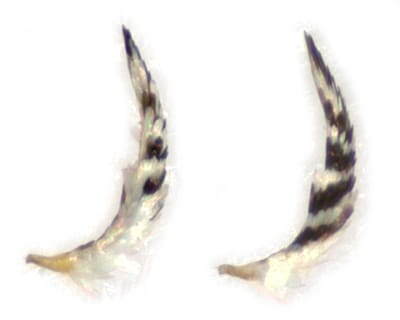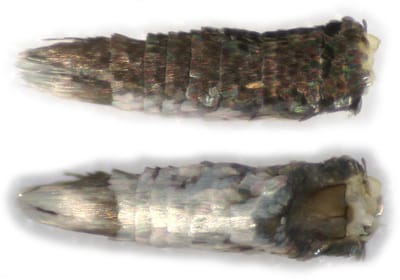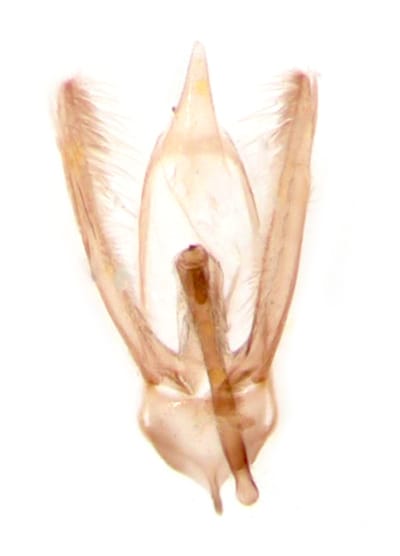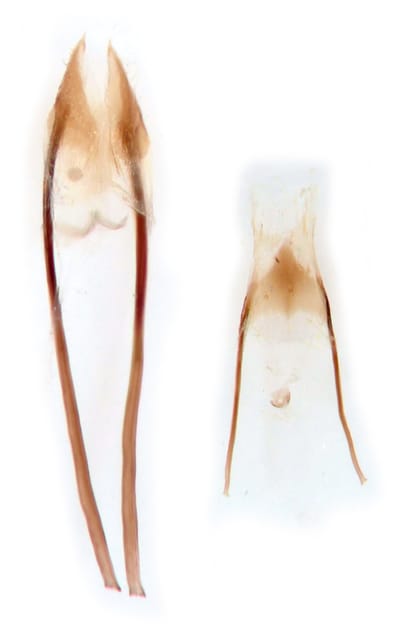19.008 Glyphipterix schoenicolella (Bog-rush Moth)
ws: 6-9mm (MBGBI2), fw 3-4mm (Sterling & Parsons); May-Sep; black bog-rush (Schoenus nigricans); NS-A in fens bogs and dune slacks Dorset to Cornwall, East Anglia, W&N Scotland
ID: from key in MBGBI2 - forewing with white strigulae (excludes G.thrasonella/fuscoviridella); no silver dot in black apical spot (excludes G.forsterella); ws <11mm (excludes G.haworthana). This leaves G.schoenicolella/equitella/simpliciella which are very similar. G.equitella is excluded in the key by having 2 pre-terminal silvery spots (the key says "pre-apical" but pre-terminal is more accurate), G.schoenicolella having only one (near the tornus) - and this may be reliable, but seeing the silvering is dependent on getting the lighting right and the strigulae in the apical half of the forewing also have some silvering which may confuse the determination of which are the relevent spots. G.equitella is larger (ws; 9-10mm) and may also be excluded by flight season (Jun-Jul); habitat (stone walls and coastal cliffs) and foodplant (stonecrops). G.simpliciella is excluded in the key by having pale fuscous hindwing dorsal cilia, these being white in G.schoenicolella - it is unlikely that this feature could be seen on a live moth. The most proximal dorsal white strigula is usually much more prominent in G.schoenicolella than in G.simpliciella. G.simpliciella flies May-Jul.
Dissection
Male genitalia: G.schoenicolella/equitella/simpliciella are all shown at Moth Dissection. Comparison of the images available reveal little difference between the species. All three have a small cornutus near the apex of the aedeagus - on the limited evidence available it appears that the cornutus is relatively long in G.equitella (length of aedagus:length of cornutus ratio 3 for G.equitella, 5-6 for G.schoenicolella/simpliciella). It may be that G.schoenicolella/simpliciella can be distinguished on the the length of the saccus, which appears relatively long in G.schoenicolella (length of cornutus:length of saccus ratio just less than 1 for G.schoenicolella, ~2 for G.simpliciella). (There is some difficulty in determining an exact position for the base of the saccus).
Female genitalia: G.schoenicolella/equitella/simpliciella are all shown at Moth dissection, but the images for G.schoenicolella and G.simpliciella show the ovipositor only. In comparing these images and my own images for G.schoenicolella and G.simpliciella it appears that all three show a small sclerotisation at the junction of the introitus vaginae with the ductus bursae and a longer sclerotisation of the ductus bursae at its junction with the bursa copulatrix. In comparing the available images it is possible that the species can be distinguished on the length of the latter sclerotisation - (length of ductus bursae:length of posterior sclerotisation ratio ~2 for G.simpliciella, ~3 for G.equitella and ~5 for G.schoenicolella) - but this may be an artefact of the preparation techniques and requires further testing. From my images of G.simpliciella it looks as though there are 2 smudgy signa in the bursa copulatrix which do not appear to be present in G.schoenicolella or G.equitella. Although it is only the ovipositor shown at Moth Dissection for 2 of these 3 species, I cannot see any significant differences in the apophyses or sterigma.
§1 Foulden Common, Norfolk; 14/08/2016; netted from Black Bog Rush at sunset
§2 Foulden Common, Norfolk; 14/08/2016; female; fw 3.4mm; netted from Black Bog Rush at sunset
§3 Foulden Common, Norfolk; 14/08/2016; male; fw 3.7mm; netted from Black Bog Rush at sunset
§4 Foulden Common, Norfolk; 14/08/2016; female; netted from Black Bog Rush at sunset
All images © Chris Lewis
§2 Foulden Common, Norfolk; 14/08/2016; female; fw 3.4mm; netted from Black Bog Rush at sunset
§3 Foulden Common, Norfolk; 14/08/2016; male; fw 3.7mm; netted from Black Bog Rush at sunset
§4 Foulden Common, Norfolk; 14/08/2016; female; netted from Black Bog Rush at sunset
All images © Chris Lewis
Page published 26/12/2016 (§1-4)



















